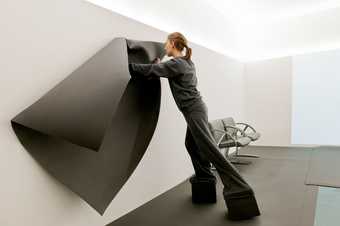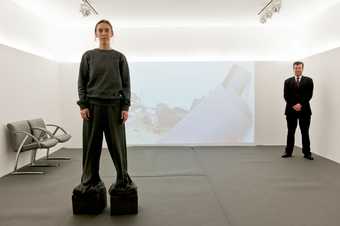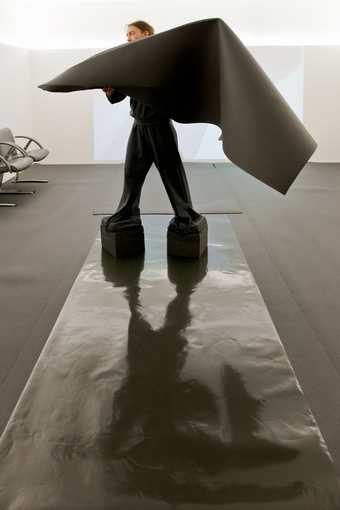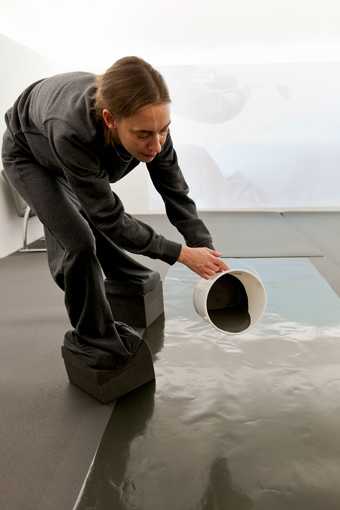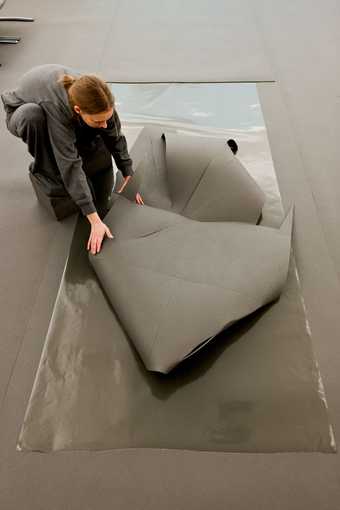Nora Schultz performed Terminal + on 11 December 2014 as part of BMW Tate Live: Performance Room. The performance was live-streamed to an internet audience from the gallery at Tate Modern, which was painted white, brightly lit and carpeted with grey sound-isolation foam. An audio recording played. There were two waiting room style chairs, a projection on the rear wall and a security guard in the space. The projection comprised live footage recorded by the small camera attached to Schultz’s left shoulder, with a few second’s time lapse. By adding her own live-stream element, Schultz interrogated to what extent her performance was live and highlighted the time delay accompanying even the fastest digital technology.
Terminal + responded to the artist’s experience of being part of the Performance Room project. The title refers to Steven Spielberg’s film The Terminal 2004, in which a man finds himself trapped in a North American airport terminal, where his passport is declared invalid and seized. He is refused entry to the country but is also unable to return home. Schultz was inspired by this concept of being forced to exist in a liminal space. However, her terminal is that of cyberspace, or her experience on the threshold between physical space and the internet in the Performance Room. Indeed the title Terminal + also refers to an unknown area on the fringes of cyberspace. In conversation with curator Catherine Wood, Schultz explained that she was interested in the juncture between being ‘a performer’ and an isolated ‘body’ while she executed her piece, and then occupying the role of ‘the artist’ explaining her ‘concept’ when she was interviewed afterwards.1
The recorded audio was a piece of dialogue written by Schultz. It consisted of a voice talking about the concept of the terminal and the position of the performer within it. A countdown from ten to one structured the content, which included digital jargon and a pseudo philosophy about life in the terminal. Schultz responded to the voice physically, nodding or pausing at different junctures. As the narration unfolded, Schultz deconstructed the room around her. She was dressed in a tracksuit attached to large foot-extenders made from the same foam as the floor covering. The extenders were used to impair her movement and destabilise the natural balance of her body.2 Schultz moved about the space, picking up and dropping sections of the foam and slowly exposing the plastic layer underneath. A bucket of grey paint was then tipped onto the plastic and Schultz used the foam as a paintbrush, folding and manipulating it in order to print large shapes on the blank walls of the room. The authoritative presence of the guard – for which Schultz was influenced by the performances of the musician Dean Blunt – also speaks to the presence of heightened security in terminal spaces both online and offline. Whether the guard was there to protect Schultz or to monitor her behaviour was left ambiguous.
Terminal + sustained a tension between virtual and real worlds, image and action. The materiality of costumes, foam and paint disrupted the cold neutral space evident at the beginning of the performance. As the artist described: ‘I do see the movement of material … as a possibility to attempt to develop a kind of language that can take place socially … together with all the alienation and the conflicts that it receives when it is installed in uncertain environments.’3 As such, the action of the performance provides a way for the audience and the performer to connect, across the terminal, across virtual space and despite their isolation.
The Performance Room series was the first artistic programme to be created purely for web broadcast. It takes place in a blank space in Tate Modern that the artist is invited to change and furnish in any way that they like. There is no audience in the room, and besides other performers, only a camera and its operator are present for the duration of the piece. Viewers from across the world are encouraged to watch the event as it happens. After the performance finishes, there is a live question and answer session between curator Catherine Wood and the artist. During this conversation the public are invited to send in questions via social channels such as Facebook, Twitter and Google+. The footage is then digitised on Tate’s website and YouTube channel and can be watched retrospectively.
Philomena Epps
February 2016

